
Posted on 04/27/2011 5:23:38 PM PDT by Ravnagora

"Real Heroes" 1942
"What Kind of Man is a Hero?"
By George J. Hecht, President and Publisher "Real Heroes" Comics and Founder of "Parents Magazine"
"Does War make heroes? On first thought you say, 'Yes, of course, war makes heroes.' And in a way it is true. A great many famous men would never have been known as heroes if war had not brought them fame. But on the other hand, the uniform does not make the man. He has to have the stuff inside him, before he puts on that uniform.
...Most of the "Chetniks" in Mihailovich's growing army of guerrilla fighters who refuse to submit to Hitler's rule in Yugoslavia, escaped and joined him with neither uniform nor guns. Some of the Greek patriots who cast their lot in with him came ragged and penniless. But they have armed themselves with guns, tanks, cannon and small arms by repeated successful attacks on Nazi troop trains and supply trucks. It took "guts" to do that."

*****
Draza Mihailovich: Comic Book Hero
Carl Savich
April 2011
The Chetnik guerrilla resistance movement led by Draza Mihailovich reached superhuman dimensions in the U.S. during World War II. Indeed, his exploits became the stuff of legend, rivaling the superheroes in comic books. Draza Mihailovich himself became a comic book hero and the Chetnik guerrillas assumed the status of superheroes.
Before television and mass market paperbacks, comic books were a dominant, mainstream form of entertainment in the U.S. The period from the late 1930s to the late 1940s became the Golden Age of Comics, a period when comic books proliferated the market. In the early 1940s, there were 125 different regular comic books published in the U.S. with sales of 25 million copies per month with a total yearly revenue of $30 million. The superhero archetype was developed during the 1930s with the appearance of Superman in June, 1938 in Action Comics #1 and Captain Marvel in the 1940s.
The first major appearance of Draza Mihailovich in an American comic book was in the September, 1942 issue of Real Heroes Comics, the cover story “The Chief of the ‘Chetniks’: Draja Mihailovich”, issue #6, published by the Parents' Magazine Press in New York. The comic book was about real-life people: "Real Heroes Comics ... Not about impossible supermen, but about real-life heroes and heroines who have made and are making history!" Draza Mihailovich, "Chief of the Chetniks", was across from New York Yankees icon "Iron Man" Lou Gehrig on the cover.
The "V for ...Victory" symbol---three dots and a dash---was on the cover. A "v" in Morse Code is three dots and a dash. The V for Victory Campaign during World War II was a symbol of resistance to the Nazis and was tied into the first four notes of Beethoven's Fifth Symphony---G-G-G-Fflat.
Real Heroes Comics was published every other month from 1941 to 1946 in 16 issues from September, 1941 to October, 1946. George J. Hecht was the Publisher and President. The Managing Editor was G. G. Telfer while the Art Editor was Ralph O. Ellsworth. George H. Gallup, the director of the Institute of Public Opinion, David S. Muzzey, Professor of History at Columbia University, and Hendrik Van Loon, the author of "The Story of Mankind", were Senior Advisory Editors.
The Parents' Magazine Institute published comic books from 1941 to 1950. Some of the comic books they published were Calling All Kids, Calling All Boys, Calling All Girls, True Comics, Jack Armstrong, Polly Pigtails, Steve Saunders Special Agent, Tex Granger, and Real Heroes Comics.
In the essay "What Kind of Man is a Hero?", publisher George J. Hecht emphasized that a hero possessed inherent human qualities that set him apart from others: "Does war make heroes? On first thought you say, 'Yes, of course, war makes heroes.' ... But on the other hand, the uniform does not make the man. He has to have the stuff inside him, before he puts on that uniform. ...Most of the 'Chetniks' ... in Mihailovich's growing army of guerilla fighters who refuse to submit to Hitler's rule in Yugoslavia, escaped and joined him with neither uniform nor guns. Some of the Greek patriots who cast their lot in with him came ragged and penniless. Bu they have armed themselves with guns, tanks, cannon and small arms by repeated successful attacks on Nazi troop trains and supply trucks. It took 'guts' to do that."
Many heroic acts go unreported and unseen: "Some of the greatest unsung heroes of all are those who remain on their farms or pretend to work in the Nazi-occupied factories in Yugoslavia and Czechoslovakia and other invaded countries, so that they can watch what goes on and sabotage the most vital points."
In "Chief of the 'Chetniks'", a large figure of Draza Mihailovich is drawn based on his 1937 photograph that became widely reproduced during the war with the description: "General Draja Mihailovich leader of the Yugoslavian guerilla army, known as the 'Chetniks!' The 'Chetniks' now numbering over 150,000, are pledged to die rather than surrender to Hitler." Draza's early career was recounted during World War I: "In World War 1 Lieut. Mihailovich was seriously wounded and decorated for bravery." Later Mihailovich joined the Yugoslav Army General Staff and was made a professor of strategy at the Belgrade military academy. His criticisms of Yugoslav defense strategy got him in trouble with the Yugoslav military authorities. Mihailovich, however, remained defiant: "Better to die than live a slave."
After the German invasion and occupation in 1941, Mihailovich vowed to resist: "I shall never surrender! ... Not I! I shall resist my country's enemy until death." He formed a guerrilla army in the mountains. Spies revealed German troop movements and weapons shipments. Chetnik guerrillas "blew up the bridge and derailed the Axis troop train." The Nazis retaliated by shooting Yugoslav hostages and by shelling and bombing more than 40 villages. "But the guerilla army grew to more than 100,000---both men and women!" The German occupation forces decreed: "For every Nazi killed, we shall butcher 100 'Chetniks!'" "Pitched battles raged all over Yugoslavia" as Chetnik guerrillas attacked Italian and German forces and "cut telephone cables" and "fired fuel stores". Trains were derailed and depots were burned. The guerrillas even published their own "underground" newspaper.
The resistance grew. People exclaimed: "While Draja Mihailovich lives, Yugoslavia is still free!" As news of Mihailovich's exploits spread, "hope was reborn in enslaved Europe." The guerrillas then blew up the Belgrade power station. The Nazis vowed: "Death to all who aid the 'Chetniks!'" Mihailovich refused to relent and continued sabotage operations, blowing up bridges. He freed German prisoners. He also forced the Germans to release their prisoners. The Germans placed a reward of "200,000 dinars ($1,000,000) for the capture of this outlaw Mihailovich!" He established "one island of resistance."
Mihailovich remains a beacon of resistance to the Nazis: "Meantime the invisible guerilla army grows like a snowball. Now it is over 150,000. The Nazis have to keep four army divisions in Yugoslavia besides their Gestapo and the Italian army of occupation. The 'Chetniks' may well be the army of liberation for all Europe." Mihailovich is made Minister of War and in the final scene from "somewhere in the woods" transmits over the short-wave radio: "I pledge myself to execute the sacred duties of my office unto death or until my country is free of the invader!"
Draza Mihailovich next appeared on the cover of the November, 1942 issue of Real Life Comics. The publisher and editor of Real Life Comics, Ned L. Pines, was a major publisher of comic books during the Golden Age of Comics. The comic book Real Life Comics was published by Nedor Publishing at 10 East 40th Street in New York City. It was a comic book series that ran from September, 1941 to September, 1952 for 59 issues. The covers were created by Alex Schomburg, one of the major comic book artists of the 1930s and 1940s. Pines also published Thrilling Comics, Startling Comics, Standard Comics, Better Comics, and Exciting Comics. Pines also purchased Hugo Gernsback’s Wonder Stories science fiction magazine in 1936 and published it as Thrilling Wonder Stories and established the Popular Library paperback series in 1942. The comic book series Real Life Comics was published every other month and cost ten cents. The comic book featured real persons such as Leonardo Da Vinci, Igor Sikorsky, Claire Chennault, and Draza Mihailovich.
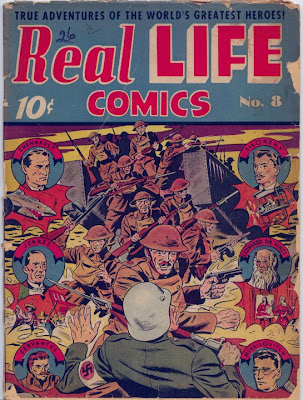
Draza Mihailovich was featured in issue No.8 from November, 1942, Volume 3, No. 2. Mihailovich was also on the cover drawn by artist Alex Schomburg. Mihailovich was in section 4 entitled “Draja Mihailovitch: The Jugoslav Hero.” The title of the story was “Draja Mihailovitch: The Yugoslav MacArthur”, comparing him to U.S. General Douglas MacArthur. The story was introduced as follows: “Drawing upon a background of military education and diplomatic skill, the commanding officer of the Chetniks has held the hordes of Hitler and Mussolini at bay.” The issue also contained comics featuring Miguel Cervantes, Leonardo Da Vinci, Johnny Appleseed, Claire Chennault, and Benito Juarez.
The comic recounted Draza Mihailovich’s service in World War I, his diplomatic assignment in Czechoslovakia in 1936 as the military attache, his imprisonment by Milan Nedich, and his emergence as a resistance leader in 1941. "For over a year he has defied Hitler and his armies--and kept Yugoslavia unconquered." He launched a resistance movement that was unprecedented: "Yugoslavia ... is the only conquered country in Europe that will not bow down to Hitler!"
The story opens with his swearing in as Minister of War: "I, Draja Mihaiilovitch, promise to carry out the duties of my office until death---or until my country is freed of the invader!" Then he is shown at 15, joining in World War I "to fight for Balkan independence". He is wounded three times. After the war he advocates guerrilla tactics: "Modern war can't be fought with old-fashioned tactics! Guerilla warfare is the only answer" As a colonel he becomes the youngest officer on the General Staff. He is court-martialed and imprisoned by Milan Nedich for his criticisms of Yugoslav defenses.
The Germans bomb and invade Yugoslavia on April 6, 1941, Palm Sunday: "The Nazis bombed Belgrade for eight hours and killed 20,000 persons!" The Yugoslav slogan was: "Rather war than a shameful pact! Rather death than slavery!" After the surrender of Yugoslavia, Mihailovich maintained: "I'm staying--to organize a guerilla army to fight the Nazis!" He created an army in the mountains to "fight for freedom".
The comic focuses on his guerrilla activities against the German occupation forces, blowing up railroad bridges, attacking German troop columns, derailing trains, engaging in sabotage, and organizing a massive popular resistance movement. The guerrillas were fighting in "our own style". The Germans retaliated by executing 50 civilians. They placed a reward of a million dollars for his capture, dead or alive. Mihailovich created his own small air force. They tied down 18 German divisions. The Germans stated that they had lost 50,000 men in Yugoslavia and needed seven new divisions from Germany. Bulgarian troops attack the Chetniks but are defeated. Moreover, the Nazis have taken 16,000 Yugoslav civilians as hostages and have arrested their relatives. Mihailovich, however, refuses to surrender: "Freedom does not come easy!" In the concluding scene, Mihailovich is shown defiant and victorious: "Outwitting Hitler at every step, inspiring his people, and setting an example to the rest of the world, the great General Draja Mihailovitch, commander-in-chief of the Yugoslav Army and Minister of War--fights on!"
Draza Mihailovich and the Chetniks also appeared in:
1) Military Comics, Stories of the Army and Navy, #14, December, 1942, Quality Comics; 3. “Mission to Yugoslavia”, The Blue Tracer, by Fred Guardineer, script, pencils, inks; 8. “The Chumps and the Chetniks”, Shot and Shell, by Klaus Nordling, script, pencils, inks;
2) Master Comics, Captain Marvel Jr., #36, February, 1943, Fawcett Comics; 1. “Liberty for the Chetniks”, artwork by Emmanuel Mac Raboy, pencils, inks;
3) Thrilling Comics, American Crusader, #35, May, 1943, Standard Comics, Nedor Group; 2. “The American Crusader Joins the ;
4) Kid Komics, Red Hawk, #3, Fall Issue, September, 1943, Timely Comics; 10. “The Origin of Red Hawk”, featuring Jan Valor; artwork by George Klein, pencils; Cover by Alex Schomburg, pencils, inks;
5) Black Cat Comics, #1, June-July, 1946, Harvey Comics; 3. “The Story of the Fighting Chetniks”, attributed to Arthur Cazeneuve; and,
6) Prize Comics, #20, March, 1942, “The Chetniks”, Ted O’Neil of the R.A.F., pages 20-25, Prize.
During World War II, Draza Mihailovich and the Chetnik guerrillas caught the American public imagination like few others before and since and became ingrained in American popular culture. They became icons and superheroes whose exploits became the stuff of legend and myth as they themselves became heroes in comic books.
*****

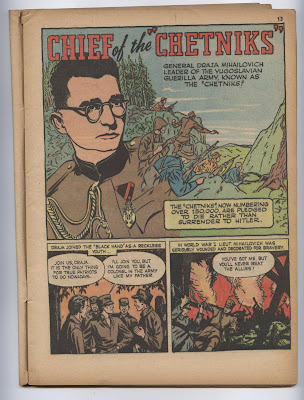
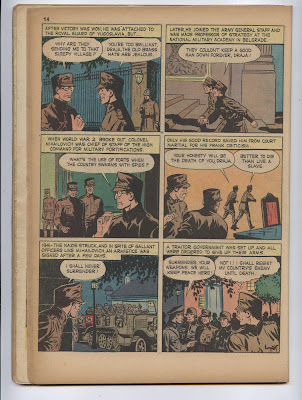
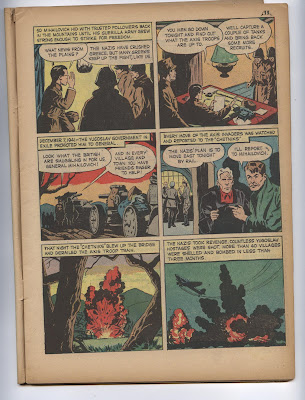
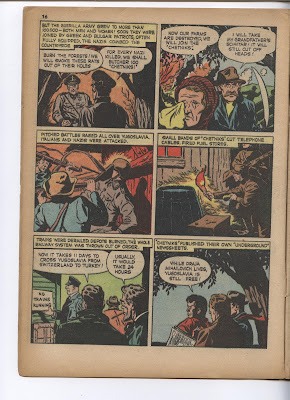


*****
Ping!
One of my professors in Med School had been a Chetnik.
Man did he hate the Nazi’s the Soviets and the Tito’s Partisans. Was fun listening to him talk politics.
Last fall I paid a visit to the St. Sava monastery in Libertyville and concluded by visiting this hero’s grave and offering the prayer “O God of spirits....”
Alleluia! Christ is Risen!
The book “The Forgotten 500” tells the story, it’ll make your blood boil and make you hate our State Department, especially then, when there may have been even more commies than now, as hard as that is to believe.
In English, the Cyrillic letters ж is transliterated as zh, ч as ch, ш as sh, j as y (i.e. Yugoslavia), џ as dzh, and ћ as ch (or more properly) tch. Therefore it's Dragolyub (Drazha) Mihailovitch or Mihalovich.
Brings back memories of 7th grade at Immcaulate Conception RC grammar school (Bridgeport) in Chicago where we were given that very comic book ...I often think of that episode ...Through the efforts of the Chetnicks 500 members of US bomber squadrons were rescued as their damaged planes crashed in the Serb mountains after bombing runs to the Ploesti oil filefs and refining centers in Romainia...and actually secretly flown out of Serbia from an airstrip the Chetnicks built for that purepose
There is a memorial to him at St. Sava, not his grave. There is an effort going on right now to locate his remains.
Its the usage of the Latinica variant.
....Its the usage of the Latinica variant....
You’re right!
Even in the Divine Liturgy prayer book, produced by the old Serbian Orthodox Church Midwestern Diocese under the auspices of Metropolitan Christopher of Eternal Memory, with parallel texts in English, Slavonic, and Serbian, the Slavonic text is in Latinica (with the Serbian text in Cyrillic and the English text as usual).
People like me who do not speak Serbian or know much Slavonic use that book so that we can understand—and even sing—the Liturgy. But we need to learn the intricacies of Latinica.
And most American Serbs or Serbian immigrants spell their names in Latinica, so we need to known it in order to pronounce their names right.
It’s too bad that we didn’t stick with Draza Mihailovich instead of switching allegiance to Tito. Blame the communist spies in the British government and then in our own State Department.
Then all during the Cold War, we Americans were taught how “benign” Tito was supposed to be. I had to go to a Serbian Orthodox church in the early 2000’s to learn how Tito persecuted Christians, for example trying to kill St. Justin of Celije. I also learned that in schools in Tito’s Yugoslavia, some teachers told their pupils that “anyone who believes in religion is stupid”.
Christopher was an interesting character, he had his likeness painted into the frescoes that are in the entry way of St. Sava.
How would you feel is someone called New York Nev York? Or Ohio as Oheeyo? English names are transliterated into Serbian the way they are pronounced, so as not to, butcher them. I think it only fair and decent to do the same for Serbian names in English, especially since the same curtesy is exte3nded to Japanese, Hebrew, Russian and other names.
As for this "Latinica", there is no such alphabet in the Serbian language. Latinica is a misnomer meaning "Latin alphabet" but specifically rafers to the Croatian Latin alphabet, which some ignorant Serbs also call "Serbian" Latin alphabet.
As such, Croatian alphabet has been cataloged internationally and registered by the Croatian government as Croatian. It was invented by Ljudevit Gaj (try pronouncing that!) in the early part of the 19th century (around 1830) and originally used for one of the dialects used in Croatia, namely kajkavian, which is really a dialect of Slovenian. Until then, Croatian dialects, čakavski and kajkvaski, were written in Italian and Hungarian Latin alphabets.
After 1850, Croatians adopted the shtokavian (Serbian) dialect as the literary standard, and created their own redaction of the same which they call "Croatian," the way Americans speak and write an American redaction or version of the English language but have the decency not to hijack someone else's language, and therefore still call it English.
Croatian Latin alphabet was first forced into Serbia when he Austrian troops entered Belgrade in 1915. This was of course reversed when they were kicked out in 1918. But the formation of Yugoslavia (correctly transliterated from Serbian—Југославија) and king Alexander's megalomania caused the usage of both alphabets in official documents.
This was then pontentiated by the Communists after 1945. In 1952, an "agreement" was made (Novosadski dogovor) in Novi Sad (Serbia), in the offices of the Communist Party, between the Croatian representatives and Serbian representatives, whereby a new bynomial language was created ex nihilo, by decree, and officially dubbed Serbocroatian or Croatoserbian. Naturally, both alpbabets became "acceptable" in either version, except that Croatians never used Cyrillic and the Serbs continued to use Cyrillic in administration and everyday life.
In 1963, however, Tito's top communist official and security chief betrayed him. Even Tito's wife was involved in what was seen as an attempted coup by Serbian generals. This led to de-Serbianization of Yugislavia until Tito's death in 1980.
Soon, the regime prohibited the use and manufacture of Serbian Cyrillic typewriters, and Latinica began to be forcibly introduced into the Serbian language and public life as a fvoritre, almost as a slogan of loylaty to Tito. Insistance on Cyrillic became subject of suspsicion, and was often criticized and denoucned as "nationalistic" or 'chauvinist", or even "something dark and undesirable".
With hea advent of computers in the early 1980's, and the fall of Yugoslavia in 1989, the former communist regime of Serbia reinvented itself and reverted back to officially calling the language Serbian, but the Tito-era scholars continued to refer to the language as "Serbcroatian", and then dropped a bomb that was impossible even in Tito's times: they announced that Serbian has two alphabets, unlike any other language in the world, which are supposedly the exact same thing in two different "graphic solutions", one in Cyrillic and the other in Latin letters. Of course the Latin version is the same old Latinica the Croatians registered as their own long ago!
Since 1994, this unbelievable lie has been repeated sufficiently that now even unsuspecting Serbs (most of whom know next to nothing about their language, especially the history of it), and many Serbs who, as refugees, came from areas in Croatia and Bosnia and never learned Cyrillic, honestly believe this lie because it's in the Serbian grammar from 1994!
The officials went even one step farther, which is to actually falsify a book from 1827, showing that allegedly the Serbs created the same Latin alphabet as Ljudevit Gaj did, and that they could therefore also claim it as "Serbian". This forgery has been debunked by the original copy of the book which is located in the Serbian National Library in Belgrade.
Finally, with much difficulty and mental resistence, in 2006 Serbia proclaimed a new Constitution (following the breakup by Montenegro), in which Paragraph 10 specifically states that in Serbia the official language is Serbian and the alphabet (Serbian) Cyrillic. There is no other official alphabet in the Serbian language and never was. Of course, some "Laitnizers" interpret the "official" to mean only govenrment usage, as opposed to public, as binding.
You can't use your immigrant sources as authoritative. They are actually victims of vicious propaganda, and education aimed at destroying Serbian culture and historical literary fabric. Unfortunately (Serbian minds are not the sharpest knives in the kitchen, some brilliant individuals notwithstanding), and collectivism rather than individualism rules.
Serbian approach to problem solving is rather strange to put it mildly. And the problem with two alphabets, one of which is foreign, is no exception. Instead of taking their time to teach those generaitons raised in Croatia and other areas where they didn't learn Cyrillic, they print books in Latinica, thus perpetuating the problem!
This is also potentiated by the impression some Serbs have that the Serbian language written in Latinica is somehow "understood" by foreigners. This stupidity has been repeated even by a number of Serbian politicians, who truly believe that "pušenje zabranjeno" is somehow understood and pronounsable by foriegners simply because it's in Latin "graphic solution."
Thanks for the information!
Dveri Srpske—for one—INSISTS on the exclusive use of Serbian Cyrillic.
As for the quality of Serbian minds, I am a bit “spoiled”. I know quite a few Serbs who are brilliant, leaders in their field of secular endeavor, and also strong Orthodox Christians and Serbian patriots. I am also aware that not all Serbs are like that, and that decades of communism, followed by years of Euro secularism, atheism, and materialism have not helped.
Of course, something similar applies to Americans, who are even more immersed in the secularist/atheist/materialist mindset. That especially applies to many liberals, who THINK that they are smarter than “dumb” conservatives, “dumb” Christians, and “dumb” Serbs, but not necessarily so!
So does a number of patriotic Serbian NGOs, such as Tchirilitsa (Cyrillic), except that the Dveri represent a religious patriotic organization organized by predominantly young people. Unfortunately, there are other youth organizations which insists on Cyrillic (rightfully so) but their political agendas are far right and extremist which only hurts respectable organizations fighting to fully restore the Cyrillic script to its rightful place in the Serbian language and culture.
IMO focusing on the alphabet usage here is somewhat of a distraction, its a bit off topic of the thread and there are plenty of Serbs here in the States who continually butcher English spellings and pronunciations. So what, its expected and I think giving such things a pass is OK.
My own name has been misspelled and mispronounced more times than I can count by colleagues and various other individuals but I have some how managed to forgive the apparent transgression. So what do you do when your name is mispronounced, do you lecture that individual ad nauseum on the proper pronunciation and or spelling?
If your name is transliterated according to international rules for Cyrillic, it will not be mispronounced. My initial comment was just calling attention to "Draza" as being wrong in hopes someone would fix it.
It became a "distraction" when a comment about "Latinica" was made, which was misleading and needed further clarification. If we honor someone, we should at least try to get his name right, don't you think?
Keep fighting the good fight!
Disclaimer: Opinions posted on Free Republic are those of the individual posters and do not necessarily represent the opinion of Free Republic or its management. All materials posted herein are protected by copyright law and the exemption for fair use of copyrighted works.